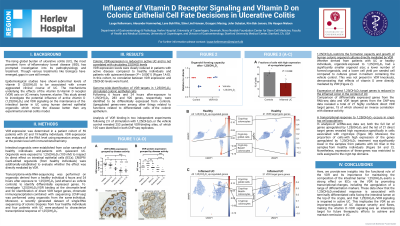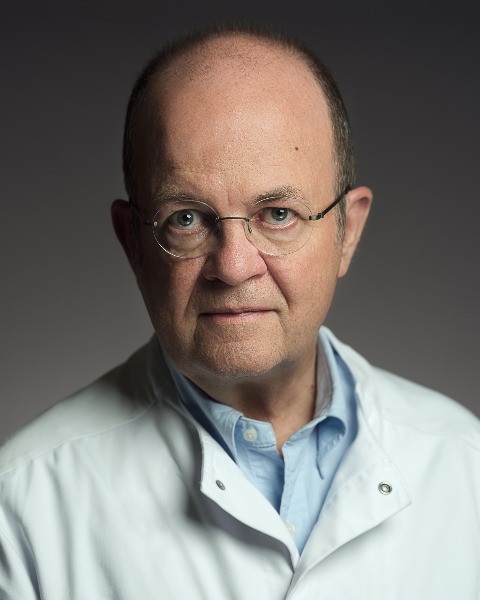Monday Poster Session
Category: IBD
P2207 - Influence of Vitamin D Receptor and Vitamin D on Human Colonic Epithelial Cell Fate Decisions
Monday, October 23, 2023
10:30 AM - 4:15 PM PT
Location: Exhibit Hall

Has Audio

Ole Haagen Nielsen
Herlev Hospital
Herlev, Hovedstaden, Denmark
Presenting Author(s)
Lauge Kellermann, 1, Lene Buhl Riis, 1, Alexander Hammerhoej, 1, Stine Lind Hansen, 2, Grzegorz Maciag, 2, John Gubatan, MD3, Kim Bak Jensen, 2, Ole Haagen Nielsen, 1
1Herlev Hospital, Herlev, Hovedstaden, Denmark; 2University of Copenhagen, Copenhagen, Hovedstaden, Denmark; 3Stanford School of Medicine, Stanford, CA
Introduction: An increased number of studies have recently elucidated both the importance of vitamin D in the pathogenesis of ulcerative colitis (UC), but also the role of its receptor, the vitamin D receptor (VDR), in the development and progression of experimental colitis. Despite an increased focus on the importance of vitamin D and VDR signaling, the mechanisms on how they affect the pathogenesis of UC remains elusive.
Methods: We strived to reveal the functional role of VDR in the human colonic epithelium regarding its effect on the epithelial homeostasis, and importance for maintaining the cellular composition of the intestinal barrier. Intestinal VDR expression was studied by immunohistochemistry, RNA expression arrays, and single-cell RNA sequencing of endoscopically obtained colonic biopsies. To characterize the functional and transcriptional effects of 1,25(OH)2D3, patient-derived colonic epithelial organoids from UC and healthy controls were used. The influence of VDR was assessed by knocking out VDR with CRISPR/Cas9 in patient-derived human organoids, and VDR binding to DNA was studied by chromatin immunoprecipitation combined with sequencing.
Results: A functional role of VDR in human colonic tissue was revealed. Thus, the experiments showed that 1,25(OH)2D3/VDR stimulation reduced organoid formation and growth by a factor of two. This effect was diminished in VDR KO organoids, indicating a regulatory effect on stem cell properties promoting the functions of differentiated cell states in a VDR-dependent manner. In human intestinal organoids, vitamin D stimulation induced upregulation of 567 genes, and of these a list of 21 direct VDR target genes was identified. We found that the transcriptional response to VDR activity was primarily identifies in fully differentiated colonocytes facing the intestinal lumen at the colonic crypt-top, albeit reduced in inflamed areas of the colon at flaring UC.
Discussion: Our study provides new insights into the functional role of VDR in the human colonic epithelium of UC and adds new clues of its impact on regulating an intact intestinal barrier function. Thus, a novel mechanism for vitamin D signaling on the colonic epithelium has been revealed, and the importance of maintaining adequate circulating 25(OH)D levels in patients with UC is emphasized. In this way, the data presented may assist ongoing efforts to define novel therapeutic targets of importance for the future management of UC.
Disclosures:
Lauge Kellermann, 1, Lene Buhl Riis, 1, Alexander Hammerhoej, 1, Stine Lind Hansen, 2, Grzegorz Maciag, 2, John Gubatan, MD3, Kim Bak Jensen, 2, Ole Haagen Nielsen, 1. P2207 - Influence of Vitamin D Receptor and Vitamin D on Human Colonic Epithelial Cell Fate Decisions, ACG 2023 Annual Scientific Meeting Abstracts. Vancouver, BC, Canada: American College of Gastroenterology.
1Herlev Hospital, Herlev, Hovedstaden, Denmark; 2University of Copenhagen, Copenhagen, Hovedstaden, Denmark; 3Stanford School of Medicine, Stanford, CA
Introduction: An increased number of studies have recently elucidated both the importance of vitamin D in the pathogenesis of ulcerative colitis (UC), but also the role of its receptor, the vitamin D receptor (VDR), in the development and progression of experimental colitis. Despite an increased focus on the importance of vitamin D and VDR signaling, the mechanisms on how they affect the pathogenesis of UC remains elusive.
Methods: We strived to reveal the functional role of VDR in the human colonic epithelium regarding its effect on the epithelial homeostasis, and importance for maintaining the cellular composition of the intestinal barrier. Intestinal VDR expression was studied by immunohistochemistry, RNA expression arrays, and single-cell RNA sequencing of endoscopically obtained colonic biopsies. To characterize the functional and transcriptional effects of 1,25(OH)2D3, patient-derived colonic epithelial organoids from UC and healthy controls were used. The influence of VDR was assessed by knocking out VDR with CRISPR/Cas9 in patient-derived human organoids, and VDR binding to DNA was studied by chromatin immunoprecipitation combined with sequencing.
Results: A functional role of VDR in human colonic tissue was revealed. Thus, the experiments showed that 1,25(OH)2D3/VDR stimulation reduced organoid formation and growth by a factor of two. This effect was diminished in VDR KO organoids, indicating a regulatory effect on stem cell properties promoting the functions of differentiated cell states in a VDR-dependent manner. In human intestinal organoids, vitamin D stimulation induced upregulation of 567 genes, and of these a list of 21 direct VDR target genes was identified. We found that the transcriptional response to VDR activity was primarily identifies in fully differentiated colonocytes facing the intestinal lumen at the colonic crypt-top, albeit reduced in inflamed areas of the colon at flaring UC.
Discussion: Our study provides new insights into the functional role of VDR in the human colonic epithelium of UC and adds new clues of its impact on regulating an intact intestinal barrier function. Thus, a novel mechanism for vitamin D signaling on the colonic epithelium has been revealed, and the importance of maintaining adequate circulating 25(OH)D levels in patients with UC is emphasized. In this way, the data presented may assist ongoing efforts to define novel therapeutic targets of importance for the future management of UC.
Disclosures:
Lauge Kellermann indicated no relevant financial relationships.
Lene Buhl Riis indicated no relevant financial relationships.
Alexander Hammerhoej indicated no relevant financial relationships.
Stine Lind Hansen indicated no relevant financial relationships.
Grzegorz Maciag indicated no relevant financial relationships.
John Gubatan indicated no relevant financial relationships.
Kim Bak Jensen indicated no relevant financial relationships.
Ole Haagen Nielsen indicated no relevant financial relationships.
Lauge Kellermann, 1, Lene Buhl Riis, 1, Alexander Hammerhoej, 1, Stine Lind Hansen, 2, Grzegorz Maciag, 2, John Gubatan, MD3, Kim Bak Jensen, 2, Ole Haagen Nielsen, 1. P2207 - Influence of Vitamin D Receptor and Vitamin D on Human Colonic Epithelial Cell Fate Decisions, ACG 2023 Annual Scientific Meeting Abstracts. Vancouver, BC, Canada: American College of Gastroenterology.
